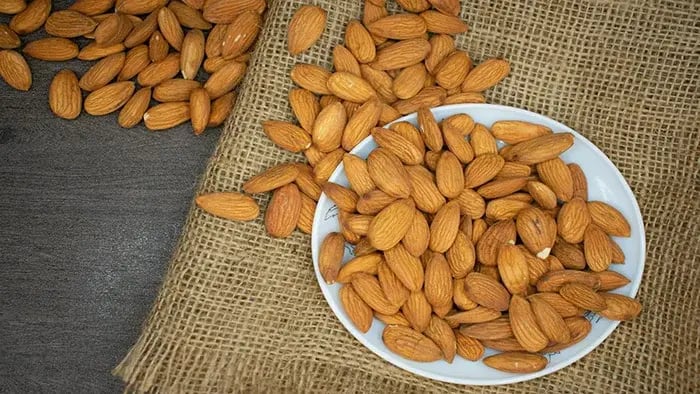- Pumpkin
- Peanuts
- Almonds
- Spinach
- Soybean Oil
Vitamin E is an essential nutrient that supports your child’s vision reproduction and the health of their blood, brain, and skin. It is also necessary for future hormonal growth and puberty growth. Vitamin E is present in many greens and dry fruits, such as almonds, sunflower seeds and more.
Understanding Vitamin E Deficiency In Kids
Vitamin E deficiency may cause many nerve and brain problems in children. It can also disturb reflexes and muscle movements, including eye-hand coordination in younger children. Vitamin E is famously known for protecting cells against free radicals and molecules when the body is exposed to harmful chemicals. Its antioxidant properties regularly help white blood cells fight diseases and build the immune system.
Severe exposure to vitamin E deficiency may result from malnutrition and a low-fat diet. Vitamin E deficiency can also be seen in children with different liver and gallbladder disorders. Children can show various symptoms, such as slow reflexes, difficulty walking, loss of position sense, coordination, and muscle weakness.
The best way to provide your children with vitamin E, to strengthen and improve their immunity, is to feed them food made with vegetable oil, a rich source of vitamin E with a bit of fat. Along with vegetable oil, many known food ingredients are Vitamin E rich, which helps your child consume a balanced meal, as given below.
5 Foods to Add To Your Kids' Diet For Vitamin E
1. Pumpkin

Pumpkins might be a boring vegetable for your children. Still, it is a great powerhouse of vitamin E as one cup of cooked pumpkin offers 2 mg of Vitamin E. Pureed, mashed, or boiled pumpkin is an excellent source of vitamin E for younger kids, too. Pumpkin is also a good choice for a balanced meal consisting of Vitamin E because it is a vegetable that is available all year round. You can also include this vegetable in soups and purees without any major taste difference but a little bit of a sweet hint, or if your child likes pumpkin, you can make a good soup out of it for them to enjoy.
2. Peanuts
Children who are not allergic to nuts are always fond of peanuts. Peanut oil or even roasted peanuts are a good source of vitamin E. It can be a good after-school snack for children who don't like to eat much. Also, if your child is active in sports, it can be a great refreshment for them during their practice. Peanuts can also serve as a great garnish, providing your child with lots of nutrients alongside Vitamin E with a smokey and earthy taste they will love. Peanuts have seven mg of Vitamin E in one ounce serving. One can also feed their child peanut butter if they don't want to eat roasted peanuts as a snack.
3. Almonds

Almonds are known for having a good vitamin E content. Not only Vitamin E, but they also provide proteins, healthy fats, and fibers. One ounce of almond contains 6mg of Vitamin E, 17% of the daily intake required for the kids. Almonds can be taken in many forms, such as almond milk or a simple garnish. Almonds taste good and have a range of nutritional benefits while keeping your child fulfilled for a longer period. Many Indian households habitually consume almonds, soaked overnight, for sharp memory. Alongside the memory, this habit can also provide Vitamin E to your kids.
4. Spinach
When it comes to greens, it is always recommended to have any kind of greens every day as they are usually full of vitamins and minerals. Spinach is no different than these greens as spinach is also rich in various vitamins and minerals, including vitamin E. One cup of raw spinach contributes to 5% of a child's daily intake of Vitamin E. Most children are unwilling to eat greens like spinach and broccoli, but making a tasty dish out of these greens, such as pesto sauce pasta, and others, always helps you sneak different minerals and vitamins into your child's balanced diet.
5. Soybean Oil

Vegetable oil has lots of Vitamin E in it, but if you were planning to switch to something healthier for your children, soybean oil is a good source of vitamin E. One tablespoon of soya bean oil provides 13% of the daily Vitamin E intake for a child. While it is best to add a little bit of oil due to calorie intake, the oil mainly consists of Vitamin E-dense factors that can be very healthy for your kid. Making a soyabean oil salad dressing can be a great idea. Soybean oil tastes like roasted peanuts and has a very dense flavor.
Smriti is a content writer who creates clear, practical, and informative content backed by science and relevant data. With a strong understanding of structured writing, she breaks down complex topics into simple, actionable insights. Her work is focused on helping readers prepare, learn, and grow with confidence and clarity.
The views expressed are that of the expert alone.
The information provided in this content is for informational purposes only and should not be considered a substitute for professional medical advice, diagnosis, or treatment. Always seek the advice of your physician or another qualified healthcare provider before making any significant changes to your diet, exercise, or medication routines.
















